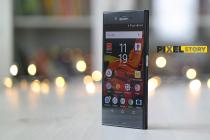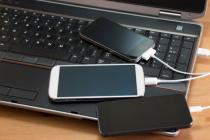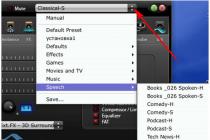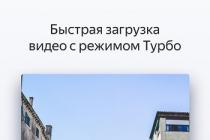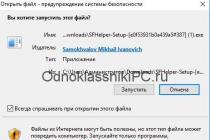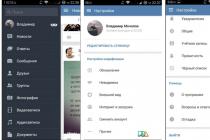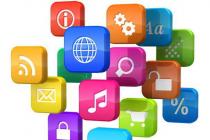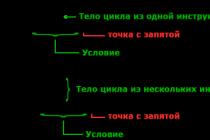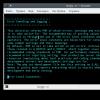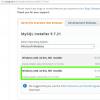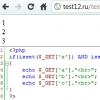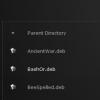This application allows you to track your current location, find out the situation on
roads in real time, as well as receive detailed instructions along the route
movement towards the destination. To avoid significant charges for roaming services before
phone.
An Internet connection is required to use the Google Maps™ application. At
When you connect to the Internet, your phone may incur data charges.
For more information, contact your network operator. Google app
Maps™ may not be available in all markets, countries or regions.
Using Google Maps™
From the Home screen, tap.
Find and tap Maps.
To use the location feature, select at least one
location method in Settings > Location & security.
More information on Google Maps™
While working with Maps, press
And then tap More > Help.
Viewing Friends' Locations in the Google Latitude™ App
Use the Google Latitude™ app to view your location
your friends on the map, as well as share your own location with them and
other information.
Determination of traffic routes
The Google Maps™ app allows you to calculate walking routes,
by public transport or by car. A destination shortcut can be added to
main screen phone, which allows you to get instructions on how to proceed with one touch
the route to this point from the current location.
When accessing the card, a connection to the Internet is created through which data is transmitted
to the phone. Therefore, in order to avoid significant costs for roaming services, before starting
Sony Ericsson does not guarantee the accuracy of the data provided by the
laying out travel routes.
Using the navigation app
Step by step instructions how to get to a given place. Voice guidance is accompanied
screen.
The navigation app may not be available in some markets.
Launching the Navigation Application
From the home screen, touch.
Find and tap Navigation.
Using the Wisepilot™ app
This app provides step by step voice instructions on how to
get to a given place. It makes it easier to plan a trip and share itineraries and
locations with friends via SMS, Twitter™ or Facebook™.
The Wisepilot™ app is not available in all countries or regions. Additional
information, including the Wisepilot user manual, see the website
www.sonyericsson.wisepilot.com.
This is the online version of the document. © Printing is permitted for private use only.
So, we are going to connect our favorite phone to the computer. What do we need for this?
1. A means of communication with a computer (data cable, infrared or Bluetooth).
2. Drivers.
3. Software for working with the phone.
4. Smooth hands :))).
5. A little patience.
And here, first of all, the question arises: what is the best way to connect? Let's look at all the tools in order.
IR port
The device is now obsolete. The data transfer speed leaves much to be desired. Through the infrared port, you can send melodies and pictures, download games to your phone. It is impossible to flash, patch, Russify and unlock the phone through it. It makes sense to buy a computer infrared port in cases where:
1. Your phone does not have Bluetooth.
2. You cannot find a data cable for your phone.
3. Connection via data cable or Bluetooth is not possible for some reason.
4. You are going to connect not only your phone to the computer, but also, say, the phones of your friends, which also have infrared ports, but it is impossible to connect them with the same data cable.
If you still decide to purchase an infrared port, then first of all, be sure to check whether your phone really works with a computer through it. Some phones with an infrared port do not want to work correctly with a computer. These include a huge number of Samsung "s, some Nokia models, Philips and LG. In all Sony-Ericsson and Siemens models, the IR port communicates normally with the computer (the exception is Siemens CL75). For phones Samsung purchase Infrared port is generally contraindicated :))).
Which infrared port is better to buy? The line of Tekram IRMate IR ports (both in COM and USB versions) has proven itself very well. Other models (especially USB) I personally do not recommend buying.
As a rule, to work with the phone via the infrared port, no programs are required, except for the actual driver for the infrared port. We connect the infrared port to the computer, install the driver for it, turn on the infrared port in the phone, direct it to the computer infrared port, we hear the characteristic sound of the infrared connection in the speakers, we see that a new shortcut has appeared on the desktop - file transfer . We take a melody or a picture, drag it to this tab, and it is transferred to the phone. Take a look at the phone screen: sometimes it first asks for confirmation of reception. Themes, games and other content are transferred in the same way. To submit games, you need to drag and drop a .jar file. If you want to transfer something from your phone to your computer, first establish a connection between them (so that a file transfer shortcut appears on the desktop), then find desired file on your phone and send it via infrared. As a rule, this is done like this: select a file, click Options - Send - Via infrared. Where will the received file end up? It depends on the IR communication settings on the computer. We go: Start > Settings > Control Panel > Infrared Communication. We see the line "By default, accept files in the following folder." This is where the received file will be. You can change the settings to your liking. Here, check the box "Allow other users to send files to your computer using infrared" - it must be on - otherwise nothing will work. For some phones, there are file managers that work via infrared.
Bluetooth
Through Bluetooth, as well as through the infrared port, you can only work with multimedia content. It is impossible to flash, patch, Russify and unlock the phone through it. Unlike infrared, Bluetooth has a much higher data transfer rate (although this difference is minimized in some phone models), works over long distances, and also through obstacles (the phone is in your pocket, while data is being transferred). Approximate data transfer rate via Bluetooth: older models of Nokia and Sony-Ericsson - 5-7 Kb/s, almost all Samsung models- about 20 Kb/s, Sony-Ericsson since K700 - about 40 Kb/s, new Nokia models - 70-90 Kb/s.
To use your phone via Bluetooth, you need to purchase a Bluetooth adapter.
The Bluetooth adapter will be an excellent choice for Nokia, Sony-Ericsson and Samsung phones, and also if you are going to connect not only your phone to your computer, but also, say, your friends' phones, which also have Bluetooth. However, if your phone has a flash card with a capacity of more than 64 Mb, then instead of immediately buying a Bluetooth adapter, you should think about purchasing a card reader - it works much faster. For Siemens and Motorola, a Bluetooth adapter is not worth buying at all - for them the best solution- data cable. Working with the phone via Bluetooth is quite simple. To do this, you need to install the drivers for the Bluetooth adapter. With them, as a rule, a program for working with Bluetooth is also installed. We turn on Bluetooth in the phone, open the program, search for Bluetooth devices, click on the found phone, select the "File transfer" service. We look at the phone screen. It should ask for Bluetooth permission and a Bluetooth passcode. Enter any number as the access code. Enter the same number in the window that appears on the computer. If necessary, once again confirm on the phone access to its file system. A window opens on the computer, which displays the contents of your phone - now you can work with it as with a disk. However, some phones (particularly some Nokia models) do not allow you to view your content via Bluetooth. In this case, an empty window will open. Try dragging some file into it - a melody or a picture - it will go to your phone. But to merge something from the phone in this way will not work. This can only be done from the phone itself: we find the desired file and send it via Bluetooth to the computer. The file will most likely end up in the My Documents\Bluetooth\inbox\ folder. If you wish, you can configure the program so that it saves received files to a different folder.
card reader
A special means of communication is a card reader - a special device for reading / writing flash cards. It is not directly related to the phone itself, but if your phone has a large flash card, it will be very useful to you. The fact is that the speed of information transfer through it to the card significantly exceeds the speed through any other type of connection. Naturally, the speed depends on the model of the card reader, the speed of the flash card itself, and the speed of the USB ports on your computer. Both the computer ports and the card reader must comply with the USB 2.0 specification for high speed transmission. Almost all modern flash cards have fairly high speed performance. Thus, a 512 Mb SD flash card via a USB 2.0 card reader is completely filled with files in about 3 minutes! Where else have you seen such speed? The only disadvantage of this method is that the flash card has to be removed from the phone. It's good when it supports hot map change. But in many phones, in order to remove the flash card, you must first remove the battery. Therefore, a card reader is an amateur device. If you use your phone as a media player and frequently update its content, then the card reader will be your best assistant.
Note. The speed of working with a flash card is significantly reduced (up to 10 times) during operations with a large number of small files. Try writing one 100 Mb file and a thousand 100 Kb files to the card, and you will see the difference. By the way, this also applies to data cables and Bluetooth.
Data cable
There are three types of data cables: COM-COM, COM-USB and USB-USB. What does this mean? The fact is that most phones use a COM interface to communicate with a computer. That's why the simplest option a data cable is a string that connects the phone's communication connector to the computer's COM port. It does not require drivers.
To date, a modification of this type of connection has become very widespread - COM-USB-data-cables. How do they work? The cable itself has a built-in converter from COM to USB and vice versa. Typically, the converter is a small box in the middle of the cord, but it can also be mounted in a USB connector - then the connector has a characteristic thickening. The cable itself is connected to the computer's USB port. If you connect such a cable without a phone, Windows will detect new hardware and require a driver for it. The driver must be on the disk that came with the data cable, so when buying one, make sure that the driver disk is included in the package. On the disk you can also find (but not always) software for working with the phone. So, after installing the driver in the device manager in the "COM and LPT ports" section, you will see a new port called, for example, "USB Data Cable". The port number will be written in brackets - remember it - it is he who must be specified in the settings of the program that works with the phone. If for some reason you do not like the port number (for example, some programs do not work with ports 10 and higher), then it is easy to change it. Open the port properties, go to the "Port Settings" tab, click the "Advanced" button and change the number. The number will also change if you plug the cable into a different USB port.
It is important to understand that the COM to USB cable does not in any way turn your phone into a USB device. It only converts signals from COM to USB and vice versa, which makes it possible to connect it to a USB port. Programs still work with the phone through the COM port, even if it is virtual. Why then do you need a COM-USB-data-cable?
1. Sometimes it allows you to work at high speeds.
2. Sometimes these cables allow you to charge your phone. Power is taken directly from the USB port. Look at the box in the middle of the cord. Often there is a switch on it that turns on charging. But if it is not there, this does not mean that the cable does not charge. Connect - check.
3. Some new computers simply do not have COM ports :))).
And another type of cable is USB-USB. This cable can only connect phones that have a built-in USB controller.
These are:
1. Without exception, all Motorola models.
2. Expensive Nokia models.
3. Siemens C, S, CX, CF, SL 65, 70 and 75 series as well as SX1.
4. Sony Ericsson K750, K790, K800, W700, W800, W550, Z520, Z530.
5. Samsung D500, D600, X700, E350, X500, X660, X670 and others.
If you connect your phone with this cable to your computer, you will see that Windows has found a new USB device and requires a driver. As a rule, drivers are the same for all phones of the same manufacturer, and they can be easily found on the Internet. As a result, by installing the driver, we get a new device - for example, a modem, a removable disk, or something else. The program for working with the phone, as a rule, immediately detects this device and works with it without any additional settings.
In addition, data cables for many phone models are compatible. This means that with the same data cable you can connect different models phones. Here is a short compatibility list:
Samsung
1. C100, C110.
2. X100, X460, X600, X620, X640, S500.
3. X120, X140, X200, X210, X300, X450, X480, S300, V200 all C-series except C100 and C110.
4. D500, D600, X700, E350, X500, X660, X670, etc.
5. D520, D800 and others.
The first three types of cables are available in COM-COM or COM-USB versions. The last two are direct USB to USB.
Siemens
1. COM-COM or COM-USB cable for all 55 and 60 series models. Also works with all A-series. Easily converted to 65-75 series. Can flash.
2. COM-COM or COM-USB for 65-75 series. Takes 55, 60, 75, 70, 75 series, all A-series models and CF110. It is an improved version of the first type of cable. Can flash.
3. USB to USB cable DCA-540. Takes all phones C, S, CX, CF, SL 65, 70 and 75 series, as well as SX1. Does not take any A-series phone, as well as 55 and 60 series. It has a high data transfer rate. Does not allow flashing the phone (except SX1).
4. Cable with a thin connector for BenQ-Siemens AL31, AF51, etc. Since these are extremely buggy devices, I do not work with them. I can only say that, at the very least, they are somehow downloaded, and even then not always.
Nokia
1. COM-COM or COM-USB cable DKU-5.
2. USB to USB cable DKU-2.
3. COM-USB cable for 6030, 6060, 1110, 1600 and some others - very similar to miniUSB, but it is not.
Sony Ericsson
1. All old models, J300, K300, K500 K600, K700, S700 (COM-COM or COM-USB).
2. K750, K790, K800, W700, W800, W550, Z520, Z530 (USB to USB).
Motorola: two types of cables:
1. Ordinary miniUSB - C350, C450, C550, C650, C380, C390, V150, V200, V220, V3, V3i V3x, L6, L7, E770, E1000.
2. Wide USB to USB cable - V300, V360, V500, V600, E398, E1.
Results
So my recommendations are:
Motorola, Siemens- definitely a data cable plus a card reader for models with a flash card.
In principle, you can get by with just one card reader if you are only interested in multimedia content.
Samsung, Nokia, Sony Ericsson:
For models with Bluetooth - a Bluetooth adapter or a card reader for models with a flash card. As for the card reader, decide for yourself. If you are going to download often and in large quantities, then it will come in handy - then you don’t need to buy a Bluetooth adapter. For other models - data cable.
Note for Nokia and SonyEricsson:
None of the above types of communications (including the data cable) allows you to flash, patch and unlock Nokia phones and Sony Ericsson. To do this, there is a special expensive equipment and software.
Notes for Samsung:
Apparently, only a data cable allows you to work on a computer with SMS and a phone book Samsung phones. If you need these features, then buy a data cable. In addition, a method for downloading Java games to D500, D600, X700, X500 and some other models via a data cable has recently been discovered. Perhaps the method will also work via Bluetooth, but I have not tested this.
Notes for everyone:
1. Naturally, you can work with your phone via Bluetooth or infrared only if these functions are available in the phone itself :))).
2. Both infrared and Bluetooth allow you to establish a modem connection and use the GPRS Internet.
3. Everything that IR and Bluetooth allows you to do can also be done using a data cable.
4. For some phone models, the data cable provides more options than Bluetooth or infrared (this never applies to Nokia and Sony-Ericsson).
Unfortunately, some phone models do not support a connection to a computer at all. Such, for example, are Nokia 2600, Motorola C1xx and others. On these phones, you will not even find a communication connector for a data cable. Other phones - for example, SonyEricsson J220, J230, Z300 - are even more offensive: there is a connector, but they don't want to connect to any. I have never found software that would work with them. Regarding Nokia with a new communication connector, which is very similar to miniUSB, but is not (1110, 1600, 6030, 6060, etc.): there are data cables and software for them, but it is quite difficult to find this software, especially for 1110 and 1600. MobiMB version 3.3.5 works with these models, but this program is not free, and its "shareware" version is extremely difficult to find (if anyone finds it, share it :))). The 6030 and 6060 also work with older versions of MobiMB, which are easy to find online.
Finally
I hope this article will shed light on the communication of your pet phone with its older brother, the computer, and help you choose the type of connection. Subsequently, I will try to describe in more detail the process of preparing and uploading media content to the phone, as well as the principles of flashing some models. In the meantime, I recommend getting software for work:
Siemens:
SiMoCo - looking for
Mobile platforms have long occupied their niche in the market, but only relatively recently have applications begun to gain popularity that make it possible to control a computer via Android via Bluetooth. Anyone can try this method of using devices. It is enough to download one of the many applications, select the desired mode and start using it. At first glance, everything seems simple, but in reality everything is somewhat different.
How, why and why
The vast majority of users do not need the ability to make remote control computer via Bluetooth. But those who are familiar with wireless technology and technology firsthand, but as a result own experience, have already managed to test and feel all the advantages of such tools. Some have gone further and completely switched to managing devices in this way. There are still few such users, but every day their number continues to grow.
The first equipment for remote control of equipment via Bluetooth appeared in the nineties of the last century. These were the most ordinary remotes: from TVs, tape recorders, toys and other equipment. But since then, both the Bluetooth specification itself and the capabilities it provides have evolved.
All applications of this designated purpose have almost the same characteristics and differ only in the functionality provided.
For example, some can only issue commands and monitor their execution. And others are capable of screen mobile device broadcast changes in real time. Thus, the computer itself turns the remote gadget into a means for displaying information.
Be that as it may, you should describe the main functions that certain utilities can provide.
Principle of operation and type of applications
As mentioned above, the toolbox is currently set by two main points:
- Bluetooth protocol version and its built-in supported modes.
- The capabilities of the applet itself.
And if earlier computer control via Bluetooth was carried out exclusively in the key of setting commands and tracking their execution, then over time, the power of the devices themselves and their software features began to reveal previously inaccessible abilities. For example, use a gadget as the main equipment for displaying information. Thus, the monitor becomes unnecessary in principle. With enough power and modern device, you can directly control the whole system unit bypassing the stationary means of information output.
Applications are currently divided into two types:
- Management of the exclusively multimedia component of the PC.
- Full control of the personal computer.
It is worth considering one program of each type, but since we are interested in complete control, the management of the multimedia version will be as concise and simplified as possible.
multimedia control
Let's take the Unified Remote applet as an example.
In both types of programs, PC control via Bluetooth is performed by installing applications both on the computer and on the device itself. Although there are exceptions. For example, modern TVs can be controlled simply from the screen of an Android device as from a remote control, only without a physical remote control. It's a pun, but that's exactly what happens.
This utility is a set of predefined positions, when clicked, the action specified in the paragraph occurs. That is, if it is written that by pressing the volume will be increased, it will happen. Everything is very simple and no frills. The most simple and intuitive.
The toolkit is very scarce, but for this kind of applets it is standard:
- Volume control.
- Change playable files.
Full control
Here we take the application Monect PC Remote for consideration. It is free and can be easily found and installed in the app store. Google Play. You will also need to install the application on your computer. Pairing information will be displayed upon startup.
When you launch the application on Android, you will be prompted to choose a connection method: Wi-Fi or Bluetooth. After choosing the pairing method, you need to select the device to be connected from the list of available ones.
Once the slave device is connected, the mode selection screen will appear with 16 different modes to choose from.
The order of their description, as well as the names will entirely correspond to that in the application itself.
Remote Desktop
This is the first mode presented, it is designed to completely replace the output device. When you click on the icon, the image from the monitor of the connected computer or laptop will be displayed on the screen.
In fact, this mode can completely relieve the PC of the need to use a monitor.
Projector
This item is designed to work with projectors. Here you will be able to select files that can be used for playback through devices of this class.
This provision was added to the program to move any files from the memory of the control gadget to the controlled computer.
Launches likeness on login file manager, where you should select the files and documents to be transferred.
Here is the file storage. Analog Windows Explorer or any other file manager. Allows you to perform almost any manipulation of documents directly from this utility.
Has enough user-friendly interface, where you can switch between different tabs that change mods and functional tools.
It has a convenient search by alphabetical index, which is located along the right side of the screen of the device. The alphabet is presented in the English layout.
Race
An emulator of a game pad designed for racing mode. It has buttons that are standard for this class of devices:
- Direction of movement.
- Brake.
- Auxiliary keys.
- It is possible to use a gyroscope.
gamepad
An almost complete emulator of the Xbox 360 gamepad. Almost everything is the same as in the original. Only the ability to click on the sticks is missing. If you get used to it - very user-friendly design and location. Good for playing old game consoles of previous generations.
Sharpened for first-person shooters gamepad. Everything is done to make it convenient to shoot any virtual enemies. For simple toys - that's it.
Here, the developers tried to please fans of flight simulators. It is possible to control all three axes. Fans of such games can appreciate the degree of convenience.
The mod is designed for easy typing or editing text. Functionality rests on pretty high level. Ease of use depends directly on the skill of typing and reading accuracy touch screen touches.
Function Keys
Replacer missing in the previous mode function keys. The entire top row of the standard keyboard is presented, as well as auxiliary keys such as Del, Ins, Home. There are separate keys to turn off, put into sleep mode or call the calculator.
I have special feelings for Sony Ericsson phones. How many had a chance to try all kinds of technology, but I don’t remember better mobile phones than SE. He himself “changed” his favorite brand a long time ago - he switched to Nokia smartphone, and I leave the good old one nearby. I don’t use it anymore (it serves a person close to me), but I don’t let go far. More useful.
Those who had the pleasure of talking with the SE T610 at one time will understand me. It was the first phone that could be said with a clear conscience - the "right" mobile phone. Small, strong, absolutely stable, with an amazingly long-lasting battery - it was a real little miracle ... The camera is so-so - I agree. But which phones at that time (four years ago) had cameras that were not “so-so”? The rest is just great.
Time passed. A whole generation of phones has changed. New series of photophones and playerphones have appeared in the product line of the Japanese-Swedish alliance. And the Sony Ericsson brand appeared in all its glory. An excellent camera - if we talk about "two-megapixel" and more complex models. Excellent sound reproduction, which is true for any models, starting with "state employees". Very good screens. Traditionally comfortable keyboards. Memory expansion with miniature cards. Great working Bluetooth. And so on and so forth.
What was missing was a normal program for synchronizing the phone with the computer. Bundled software (called, of course, “suite”, they always have, like something hefty and barely crawling, so already the “suite” is a malicious pebble in the neighboring Nokia garden), a huge clumsy software package, I don’t want to take it seriously. I installed it, launched it a couple of times and… demolished it with relief. And I do not advise you to toil with this thing. A total disappointment...
I immediately remembered the wonderful musical gadgets from Sony - mini-disc players. Remember those? They are still found in stores (MD discs themselves for sure), but less and less often. They killed this wonderful portable system the creators themselves - with the exotic ATRAC codec and the wise computer synchronization program. And what do you want - a closed system is a closed system. Don't count on massive popularity. And against the background of the general distribution of cheap MP3 players, the MD system did not have a single chance. Dying technology...
I was very saddened by this inattention of the world's leading manufacturer to the users of its products. Like, they bought a phone and - good bye. And figure it out yourself, pigeons, as you know. If not scrap, use our monstrous synchronizer. And if you don’t like it, use ... whatever you want ...
And suddenly the floAt`s Mobile Agent program or simply FMA caught my eye. It is the product of a free community of programmers, native to the army of "computer aristocrats" - Linux users. Hence the characteristic qualities of the program. It is large, somewhat thoughtful in work, but flexible, well customizable for any task, stable and very convenient in daily use. You should not expect interface embellishments from FMA, they simply do not exist. There is a clear, precise interface, including Russified. Good Russification is very important, because the phone is not a high-tech toy, like, for example, a PDA, but a communication tool for millions of people, including those for whom computer technology is a dark forest.
I used FMA for a year and a half. But with the transition to Vista (and before that, by the way, to another mobile platform), this program was abandoned. The reason is that the interface is too primitive. You quickly get used to the beautiful (and Vista has "ruffles" and "pumps" are hardly the main advantage). In addition, a better program was found - in my purely subjective opinion, of course. For those who disagree with me, I’ll tell you - FMA works not only with Sonerics, but also with a huge number of other models. It's just that SE is better than the rest, because the program has some specific add-ons created specifically for Sony Ericsson mobile phones.
This, in particular, is about the computer remote control applet. When you establish a connection between the computer and the phone, the buttons on the mobile phone turn into remote control buttons. You can control the cursor, launch programs, control a media player (any, including my favorite iTunes) from your phone, and, in general, do a bunch of things. Try this feature for sure - someone will definitely like it ...
Another synchronizer program settled on my computer a little later than FMA. I'm talking about the program MyPhoneExplorer. It is not so ornately arranged, but it looks very personal. To such an extent, "nothing", which forced out the powerful FMA and firmly took its place.
But there is one detail that should not be ignored. If I continued to use the T610, I would most likely leave the FMA. But the phone passed into other hands - as a temporary replacement (the old mobile phone was stolen in the subway and we are still not going to buy a new one, let's say - we are waiting for fresh models from Sony Ericsson). Forcing a woman who is not very keen on high-tech toys to delve into the settings of a large program in order, for example, to establish a connection via Bluetooth, is, in my opinion, inhumane. And some super-needed to me, but absolutely useless for her, synchronized calendars and event planners turned out to be unclaimed. Therefore, the old FMA went to the “treasury of usefulness”, and MyPhoneExplorer established itself as the main synchronizer. Now it works in parallel with Nokia PC Suite. And I, frankly, envy my faithful companion. I have to endure the "brakes" of the Nokia package, and she dumps the address book, melodies, pictures on the computer effortlessly, in one minute ...
I intend not to go into the details of setting up FMA and MyPhoneExplorer. If we talk about anything in detail, it's about native synchronizers (from Sony and Nokia). There is something to tinker with. And here everything is very simple ... No, there are some difficulties - with FMA. But they can be sorted out. The main thing is to correctly designate the number of the virtual COM port in the settings so that the computer sees the phone. The rest is already easier.
So, MyPhoneExplorer was created in Germany. Therefore, German is his native language. But the interface of the program is multilingual. During installation, you are prompted to select the language in which you will communicate with the phone. And you will receive a fully Russified program, moreover, translated with high quality and without errors.
In MyPhoneExplorer, you can find several useful additions, which, however, FMA also has. For example, synchronizing clocks over the Internet. Not a clock of a computer and a phone, but just like that - a clock of a phone with remote server time (in other words, with "atomic" clocks). The main thing is that the computer is connected to the Internet. The program itself will do the rest.
There is no remote control in this program, but, as it turned out, I don’t need this thing (because I work on a laptop, which is always at a minimum distance, literally under my nose - what kind of remote control is there). But there is a virtual telephone keypad - a kind of built-in phone emulator, a system for backing up the contents of the mobile phone's memory to a folder selected on the PC hard drive, a convenient file navigator that simplifies the transfer of music and photos to the phone and back. As I said, the program is very pleasant.
Updates are released quite often (which, by the way, cannot be said about FMA). This is due to the release of new models of phones from Sony Ericsson. To date, I do not know of another similar program that would fully support the latest SE phones.
What else? Oh yes, the program is completely free. If anyone is sure that free cheese is only in a mousetrap, then this is not the case. The program does not ask for money. Displays only at the moment of closing the application a window with a proposal to thank the author. Click OK and the window will disappear. A small, right, cost for such functionality. Although ... I would really thank the guy for this work (and I will definitely do it). Try it yourself - the program is worth it.
Cell phone, PDA, MP3 player, voice recorder, small camera. Wouldn't it be too much? Nobody canceled the wallet with the keys. And putting on a vest with two dozen huge pockets, while inflating to an incredible size, is sheer ... avant-garde. Since we are all “digital” people in one way or another (otherwise we would hardly have looked at this portal), the obvious conclusion suggests itself - you need to somehow minimize your personal set of portable equipment. Either leave some of the gadgets at home (why did they spend money on these things then?), Or look for something universal and multifunctional.The task is not difficult. Today, any decent phone can take pictures, record speech, play music, and do everything that a pocket computer does. That is one small phone, and no problems. Well, there are keys, a wallet, a lighter ... However, we have already talked about this.
However, the phone is different. There are, for example, smartphones and non-smartphones. Among smartphones, there are those that are based on (or simply, S80, S90), and those that are based on Windows base Mobile (they are called WM for short). Other options, like, we will leave aside for now. And among non-smartphones there is excellent technology from the consortium. Having gone through a lot of devices from Nokia and various Asian manufacturers, I will take the liberty of saying that smartphones are great cars, but they take some getting used to. There are other "ambushes". Early models of the WM family, for example, suffered from frequent and unpredictable fainting spells. Smartphones from Nokia are no different long time battery operation. A couple of hours of reading a book from a smartphone screen, some music and - we are left with no connection at all. And Sony Ericsson machines are both productive and long-lived. And they can do a lot, not much inferior (but still, I would add, inferior) to smartphones in terms of functionality. Maybe that's what made them so popular.
Don't get me wrong, I'm not against smartphones at all, quite the contrary. Cars of the WM family, for example, have an excellent ease of use synchronization system with personal computer. This is the "good old" (actually new, but still ... good) Microsoft ActiveSync. Synchronizes everything (it would be strange to expect the opposite). Although not without quirks ... And for Nokia there is a whole proprietary connection of a smartphone to a computer -. Plus alternative solutions like .
And yet, just a phone from Sony Ericsson in many respects outperforms the most equipped, most advanced smart phones. Easy to operate, the phone from SE in terms of technical excellence will give odds to any smartphone - if, of course, we are talking about top models like the W890i and the like ( , for example). Highly quality screens, comfortable keyboard, durable housing. In terms of design perfection - external, felt by the hand, and not just by the eyes, SE phones can be compared with handheld computers Palm. If a monoblock, then it’s not a slippery “remnant” at all. If a clamshell, then with an ideal fixation of the halves in the open state, without backlash and, moreover, rattling.
Yes, few programs have been written for the Mophun environment. Games wagon and a small cart, and serious applications once, twice, and miscalculated. But there is Java (its J2M variant, of course). And on SE it is implemented just fine. And in Java on the same Web, you can find so many curious and really useful programs, which is not worth listing (maybe some other time). Add to this magnificent built-in photomodules with good optics and autofocus, memory expansion cards, musical abilities, and finally, it is not for nothing that the models of the Wxxx family received the name Walkman ... The picture turns out magnificent.
But most of all, the synchronization system with a PC attracts. And the merit in that is not at all the developer company (I don’t like proprietary software at all), but the enthusiasts. There is no such wealth of programs for any other cellular platform. There are paid ones, like MOBILedit! (but I won’t talk about it, because I didn’t particularly like this program - which, by the way, does not mean at all that it is bad). There are free ones like floAt`s Mobile Agent and MyPhoneExplorer. Let's talk about them.
The floAt`s Mobile Agent program, despite the tricky name, is perhaps the most popular package for synchronizing phones with a computer. This is the product of a free community of programmers, native to the army of "computer aristocrats" - . Hence the characteristic qualities of the program. It is large, somewhat thoughtful in work, but flexible, well customizable for any task, moderately stable (everything in this world is stable only in moderation) and very convenient in daily use. Interface embellishments should not be expected from floAt`s Mobile Agent, they simply do not exist. There is a clear, precise interface, including Russified. Good Russification is very important, because the phone is not a high-tech toy, like, for example, a PDA, but a communication tool for millions of people, including those for whom computer technology is a dark forest.

So, download the installer, install the program. Let's launch it. AT tray windows a tiny icon will appear cell phone(upon close examination, you can recognize my glorious old man, who is still alive and well). Right-click on the icon and select "Restore" from the menu that appears. The working window of the synchronizer opens on the monitor screen. In the left part of the window there is a hierarchical multi-level column of folders, in the right and main parts of the window it is still empty ... Let's go to the settings. This is the main menu item "Service" and the first item "Options". We need the Connectivity tab (the Russification of the program is not global, but this is not a sin, but a small sin).
Let's digress for a minute. There are three ways to connect your phone to a PC - through USB cable, via slow infrared and via relatively nimble Bluetooth. If available in Bluetooth phone(and only the youngest models of phones from Sony Ericsson do not have it) it makes sense to equip your computer with this thing. Believe me, the expenses are very small (today no more than $ 30), and the convenience is simply invaluable.
We connect the Bluetooth adapter, a kind of “dongle” or “stick”, similar to a flash drive (oh, this computer terminology - new technology appears faster than the words denoting it), we connect to the USB port of our computer. In this case, it is better to connect the adapter once and not touch it again. The problem with virtual COM port x that operating system prescribes to the adapter. When you change the USB port, the address of the COM port will also change, and we will have to reconfigure the synchronization program.
The Bluetooth adapter comes with a CD with Widcomm or Soleil software. The first has more customization options and is better protected, the second has a fun interface and more intelligible (from the point of view of not very experienced user) support. wireless devices. For example, Soleil allows you to connect a wireless headset to your computer to use a software voice recorder or listen to audio books (it's hard to listen to music, the sound quality is very poor) ... But we don't need any of these programs. Then, everything later, if you want to experiment and find out the full range of wireless Bluetooth technology. For now, the Bluetooth support built into Windows XP will suffice. True, a second “service pack” is definitely needed; without it, this system will not work.

Click on the tray icon with the Bluetooth icon. Select "Open Bluetooth Device Settings" from the pop-up menu. In the first tab "Devices" click on the "Add" button. We turn on Bluetooth on the phone and give the computer a little time to search for a new device. We register access keys on the computer and phone, following the instructions of the setup program. Then, when everything is connected (and usually there are no big problems - Microsoft has provided very good Bluetooth support), go to the "COM ports" tab and see what the window of this configuration utility shows us. However, you may not do this. In the settings of floAt`s Mobile Agent, in the bottom item of the Connectivity tab, only the actually used COM ports will be shown. Using an experimental method (it’s easier this way), we try each of them by pressing the “Search for device” button. If successful, the message "Found device such and such" will be displayed. That's it, click OK, exit the settings (this will happen automatically), in the main menu of the floAt`s Mobile Agent program, open the first item "Phone" and the second option from the top "Connect". And let's see what happens...
I will not paint all the advantages of this synchronizer, you will see for yourself. Let me just say, it's great. By the way, take a look at your phone, in the "Accessories" menu (owners of Sony Ericsson phones know where to find it - in the "Communication" applets group). There you will find a new FMA point. Actually, when connected, a certain Main Menu will be displayed on the phone screen, which is usually turned off by the user immediately out of caution. You can call it again from the "Accessories" menu ... Do you know what it is? This is a multifunctional, highly flexible and powerful wireless remote control for your computer. The phone also becomes a remote control. And what a remote!
There is not much space left for the second program of this story. But you should definitely try MyPhoneExplorer. This program is not as heavy as floAt`s Mobile Agent and is noticeably simpler. But very beautiful. And the connection with the phone via Bluetooth is faster - I don’t know what the reason is. The settings system is also simpler. But, I repeat, the beauty is incredible. And a very handy organizer to boot.

These two synchronizers can be safely classified as high-quality, well-written programs. Both live on my computer. And both are used equally. By mood. I wanted a little more opportunities - I launch floAt`s Mobile Agent, my soul asks for aesthetics - I exit the first one, launch MyPhoneExplorer. Both programs are Russified (by the way, I forgot to mention the high-quality Russification of MyPhoneExplorer, the program itself is German). Both are free. Both are extremely functional and comfortable.
You know, in the last year, my faithful pickpocket Palm has been lying around doing nothing. In fact, my daughter plays it. And I even read books from the phone screen. If you have to write and receive SMS, then here I am generally the king. On a large computer keyboard, typing messages is a pleasure. And, of course, reading...
The cell phone has one big unresolved problem. It is impossible to write on it. On the Sony phone Ericsson is perfect, except for SMS (a phone keypad is also enough here). On a smartphone, you can use an external Bluetooth keyboard. This is what I consider to be the indisputable advantage of smartphones ... Where can I find good program synchronization?
© Nikolai Nadezhdin,

